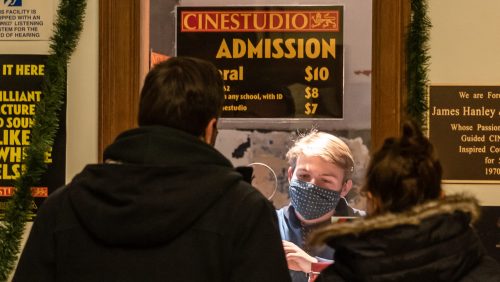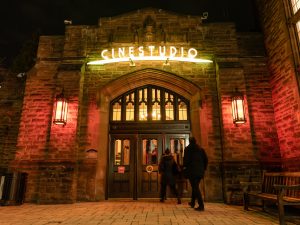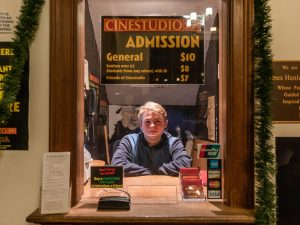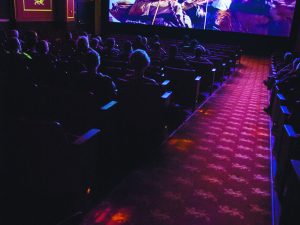The Student-Founded Movie Theater Marks 50 Years on Campus
Originally published in The Reporter, winter 2020.

BY ANDREW J. CONCATELLI
PHOTOS BY HELDER MIRA
From across Trinity College’s Main Quad, a gleaming new sign beckons.
Inside, seating in the balcony offers a respite from the busy world.
The grand golden curtain rises on the 37-by-16-foot screen as the projected image blinks to life and the film begins to play.
This is Cinestudio, the independent movie palace that celebrates its 50th anniversary this year. And to its intrepid founders, dedicated student volunteers, and passionate patrons, there’s no other place like it.
“I don’t think they quite understood what we had planned”
Entering an unmarked door in a hallway of the Clement Chemistry Building, James Hanley ’72 climbs the narrow staircase up to Cinestudio’s projection booth, as he’s done countless times over the last 50 years. “This is the door we had to take off the hinges of to get into the booth for the first time,” he says.
In 1969, students in the Trinity Film Society—of which Hanley and his Cinestudio co-founder Peter McMorris ’73 were both enthusiastic members—had secured permission from the Chemistry Department to show films in the chemistry lab auditorium after finding themselves without a screening venue. “I don’t think they quite understood what we had planned,” Hanley says with a grin. The problem was, nobody had a key to the booth, which had fallen into disuse.
“We went at 2:00 in the morning and got in there. We found two 35mm projectors from the 1930s, when the building went up,” Hanley says. “Soon, students were hanging up bedsheets as a temporary screen as we prepared for a theater that would serve both students and the community. At the time, there was such a whirlwind of activity here on campus, and this took on a life of its own.”
The first public screening on February 16, 1970, was a double feature of Yellow Submarine and Alice’s Restaurant, for which the Film Society’s faculty adviser, Lawrence “Larry” Stires of the Modern Languages Department, put up $500 of his own money to secure the public rights. “We sold out every night for a week. We even turned away lots of people,” Hanley says. “We put on a big picture with really good sound, and we always have; it just was the ethos of the place. We hit at the right time and the right place.”
McMorris adds, “Trinity was going through huge changes in that time, from one kind of college to another. We were part of that change, part of the new. This space provided us a venue to express ourselves. Even today, if there’s a film out there that needs to be seen, we will show it.”
At first, the student-run organization was met with trepidation by some on campus. “There were a few conservative faculty members who were uneasy about us,” Hanley says. “We were showing some political things. It wasn’t just entertainment; we were showing films that were enlightening people. And we did things that shocked people, like painting the lobby red. But [former Trinity President] Ted Lockwood [’48, H’81] was a great supporter of ours and [former Trinity Vice President] Tom Smith [’44, H’88] went to bat for us over our freedom of speech.”
In the ensuing 50 years, Cinestudio has embraced technological advancements while engaging in a historical mission, bringing back older film titles, preserving a vital legacy of the past, and showing the films exactly as originally presented to ever-new audiences—all while staying true to its independent origins.
Hanley and McMorris worked at other jobs at first and ran Cinestudio unpaid for many years. “Everybody was doing it for the love of it,” Hanley says, “but at a certain point the students and alumni wanted to have a more permanent structure so they knew Cinestudio would continue for future students. The first stage [around the late ’80s] was to hire us and Larry Stires—we weren’t being paid much—and we provided an ongoing presence and leadership.” Interest from donors in making tax-deductible donations directly to Cinestudio, rather than through a fund at Trinity, led to its establishment as a nonprofit 501c3 organization in 2005.
Today, the venue features approximately 450 new seats that were installed in 2018 and is equipped with a legendary Dolby sound system and state-of-the-art digital projector, while retaining its 35mm and 70mm film projectors for classic movie presentations.
“It’s hard to describe this place,” McMorris says. “I learn something new every year. It’s an industry that is changing constantly, and to keep this place going, you have to anticipate those changes and make adjustments.”
Hanley adds, “When we first started out, one of our goals was to show films in a much better setting than most theaters, with a high technical quality. Over the years, we’ve been able to not only maintain that but enhance it.”
“Students have gotten their education at Cinestudio”
Today—in addition to being an art house cinema open to the public—Cinestudio is a part of both the academic and social worlds of the college, with faculty, staff, and students all taking advantage of a special facility in the heart of campus. “Cinestudio has been the ground on which we’ve built the film program,” says Associate Professor of English Prakash Younger, director of Trinity’s Interdisciplinary Program in Film Studies and a member of the Cinestudio Board of Directors. “We see film as a lens into everything. We include philosophy, political science, and classical studies courses in our curriculum,” he says.
Milla C Riggio, James J. Goodwin Professor of English, Emerita, who helped to create the film studies program at Trinity and now serves as secretary of Cinestudio’s board, taught several film courses that made use of the theater. “I taught ‘Film Noir’ and ‘The Western Film,’ among other courses. James [Hanley] and I taught a first-year seminar in Cinestudio, where we held the classes, focusing on films shown at Cinestudio,” she says.
Younger adds, “Students have gotten their education at Cinestudio. I was part of a very special first-year course that was taught there called ‘Thinking through Film,’ which helped to enhance the connection between Cinestudio and the academic offerings.”
Connections are made at Cinestudio between Trinity and the Hartford community as well. “With Cinestudio as such an independent place—though very much supported by the college—it’s a portal into the broader culture outside of the campus,” Younger says. “It is truly a gem of the area in terms of the quality that generations of people both from Trinity and the community have enjoyed. Watching a movie there is like nothing else.”
The theater hosts regular daily screenings and special film festivals, including the “Reel Youth Hartford Film Festival” for local high school and middle school students; the “Connecticut LGBTQ Film Festival,” founded at Cinestudio in 1988 and presented by Out Film CT; and the “April in Paris [French] Film Festival,” organized by Trinity’s Department of Language and Culture Studies. Cinestudio also screens live events from Moscow’s Bolshoi Ballet and London’s Royal Opera House and National Theatre.
Trinity Film Festival (TFF), held at Cinestudio each spring since 2012, is a platform for undergraduate student filmmakers from across the country to network and see their films on the big screen. John Michael Mason ’12, M’14, now Trinity’s head track and field coach and chair of Cinestudio’s Board of Directors, founded TFF as an undergraduate. “Cinestudio was one of the reasons I chose to attend Trinity,” he says. “Seeing a film in a theater with other people is a profoundly different and better experience than watching in your own home, on a computer, or on a phone. The communal aspect of it, the darkness, and the clarity of image and sound are all things Cinestudio holds paramount, unlike any theater I’ve ever experienced.”
With Hanley, McMorris, and two part-time projectionists as the only paid staff, Cinestudio is run largely by student volunteers. Claire Pritchard ’20, who is double majoring in biochemistry and theater and dance, serves as Cinestudio’s lead student volunteer coordinator. “Cinestudio is an amazing venue and opens people up to the fact that movie theaters are alive and well,” says Pritchard, an Elizabeth Elting ’87 Bantam Bold 1823 Scholar. “I’ve learned a lot about working on teams, communications, publicity, and being able to market anything.” Student volunteers program the “Moonlight Movies” series one Friday night per month. Sponsored by the college’s Office of Student Activities, Involvement & Leadership (S.A.I.L.), these movies are funded so they are free to students with a Trinity ID. “We try to make it as accessible as possible for students,” Pritchard says.
Hanley adds, “It’s a very rare combination for a college campus to have a nonprofit movie theater open to the public, with students who actually manage it and also are a part of its future.”
“Cinestudio will continue as an integral part of the campus”
To celebrate its 50th anniversary, Cinestudio will host special screenings on February 22 of the two films that started it all, Alice’s Restaurant and Yellow Submarine. Alumni and past volunteers of Cinestudio also will be invited to a reception on May 2 that coincides with this year’s TFF. The gathering will serve as a recognition of all those who have helped the organization succeed in its first 50 years.
“I can’t say that I’ve ever regretted it for a minute,” Hanley says. “It started with a student impetus and has remained student centered right down the line. I’m very optimistic that Cinestudio will continue as an integral part of the campus.”
As Hanley and McMorris begin to think about retiring from their roles as executive directors of Cinestudio in the coming years, plans are being made to ensure that the organization they created will go on.
“The 50th anniversary is in many ways a celebration of all that James and Peter have done over the last five decades,” Mason says. “We’re working hard as a board to put ourselves in the position to continue that legacy for another 50 years. Cinestudio could only exist and grow because of what Trinity is: a place where people with ingenuity are supported, where there’s a larger community outside of the college, and where students are given the room and encouragement to take their dreams and turn them into reality.”


